Essential Feeding Bottles for Newborn Kittens
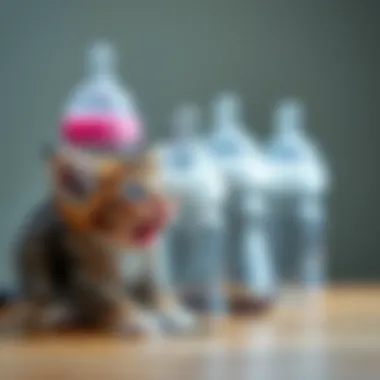
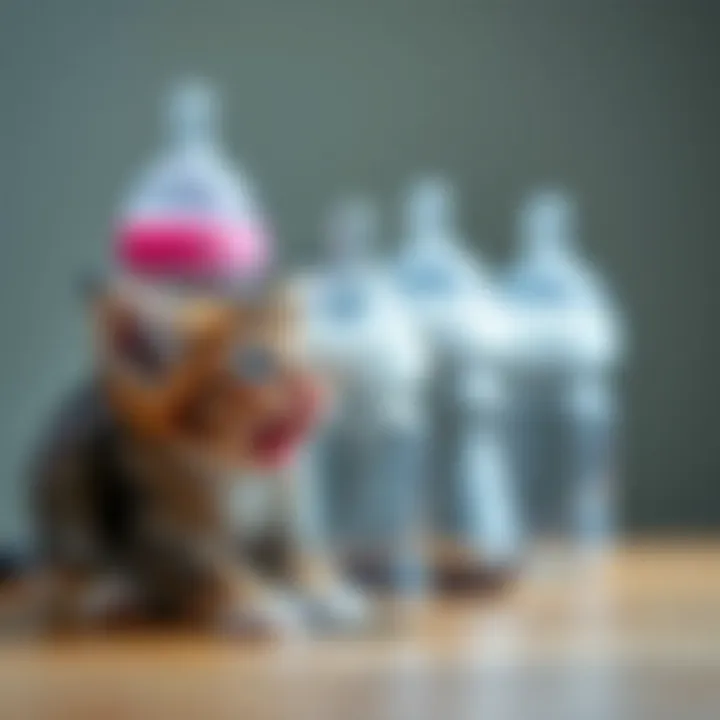
Intro
Caring for newborn kittens, especially those without a mother, is a delicate endeavor. A critical aspect of this care is feeding, and the right feeding bottles can make a world of difference. Specialized feeding bottles designed for these tiny creatures help replicate the nursing experience, ensuring that they receive the vital nutrients they need to thrive. Also, choosing the correct type can prevent potential health issues that stem from improper feeding methods. This guide aims to explore the ins and outs of feeding bottles for newborn kittens, including the best practices for their use and the common challenges owners may face.
Pet Care and Grooming
When it comes to caring for newborn kittens, grooming plays a subtle yet vital role. While the thought may conjure images of fluffy coats and playful antics, grooming is particularly critical in the early weeks of a kitten’s life.
Importance of Regular Care
Even as delicate as they are, newborn kittens do need regular attention. Grooming ensures the removal of dirt and debris, and it also promotes healthy skin and fur. Additionally, a clean kitten is less likely to attract unwanted pests. Regularly checking for signs of health issues like skin irritations can catch problems before they escalate.
Grooming Techniques by Pet Type
While we are focused on kittens, it’s worth noting that different breeds may have diverse grooming needs. For instance, a long-haired Persian requires more frequent brushing compared to a short-haired Domestic Shorthair.
Tools and Products Recommendations
When setting out to groom these tiny furballs, here are a few products you might consider:
- Soft-bristled brush: Ideal for gentle brushing to avoid skin irritation.
- Flea comb: A handy tool to check for pesky fleas that can harm your kittens.
- Pet wipes: Useful for quick clean-ups if a bath isn’t feasible.
Seasonal Care Tips
Kittens tend to be more sensitive to weather changes than adult cats. In warmer months, ensure they have plenty of shade and water. For those chilly winter nights, a cozy blanket can provide extra comfort and warmth.
Health and Nutrition
Feeding newborn kittens properly lays the groundwork for their overall health. The nutritional requirements during the first few weeks of life are substantial, as they are growing rapidly.
Understanding Pet Nutrition
Kittens rely heavily on milk for their nutrients, ideally from their mother. However, for orphaned or nursing kittens, a milk substitute like powdered kitten formula must be utilized. Never use cow's milk as it can cause digestive upset.
Common Health Issues by Species
In the case of kittens, a common ailment is dehydration, especially if they aren’t receiving adequate nutrition. Regular vet check-ups are essential to ensure their health remains on track.
Preventive Care and Regular Check-Ups
A proactive approach to health can prevent many issues. Regular evaluations by a veterinarian can catch potential problems early.
Food and Dietary Advice
Utilizing appropriate feeding bottles is key. The bottles should mimic the mother's teat, allowing for natural sucking. Finding the right formula and administering it correctly can make all the difference in a kitten's development.
Behavioral Training
Interacting with kittens is not just about feeding and grooming—it lays the foundation for their future behavior. Positive reinforcement techniques can help kittens develop into well-adjusted adult cats.
Basics of Positive Reinforcement
Using treats or affection as rewards teaches kittens what behaviors are acceptable. It is important to be consistent.
Training Techniques Users Can Apply
Simple techniques can be used, such as teaching them to come when called. It's often as easy as associating their name with a rewarding treat.
Managing Behavioral Issues
If a kitten shows signs of anxiety or aggression, understanding their triggers is essential. Often, these behaviors can stem from environmental stressors.
Importance of Socialization
Kittens should be introduced to various stimuli, including people and other animals, to build their confidence. This is crucial before they reach around 9 to 12 weeks of age, which is often considered the optimal time for socialization.
Engaging Activities and Enrichment
Kittens are full of energy, and providing them with engaging activities can help channel that energy positively.
Fun Games to Play with Your Pet
Simple games like tossing a crumpled ball of paper or engaging them with a string can keep them entertained.
DIY Toys and Activities
Creating your own toys can also be a fulfilling option. For example, filling a cardboard box with soft fabric and hanging some ribbons can be a homemade play space for kittens.
Importance of Mental Stimulation
Mental exercises are just as important as physical ones. Puzzle toys that release treats can engage a kitten's mind and prevent boredom.
Outdoor Adventures and Exploration
If safe, allowing a kitten to explore the outdoors can provide them with varied experiences. However, always supervise these outings to ensure their safety.
Resources and Community Engagement
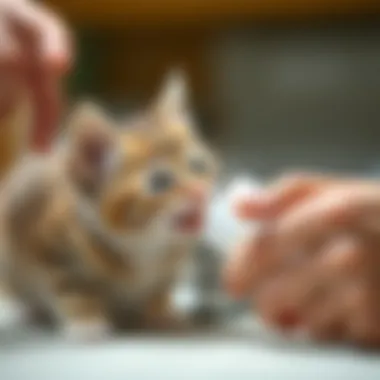
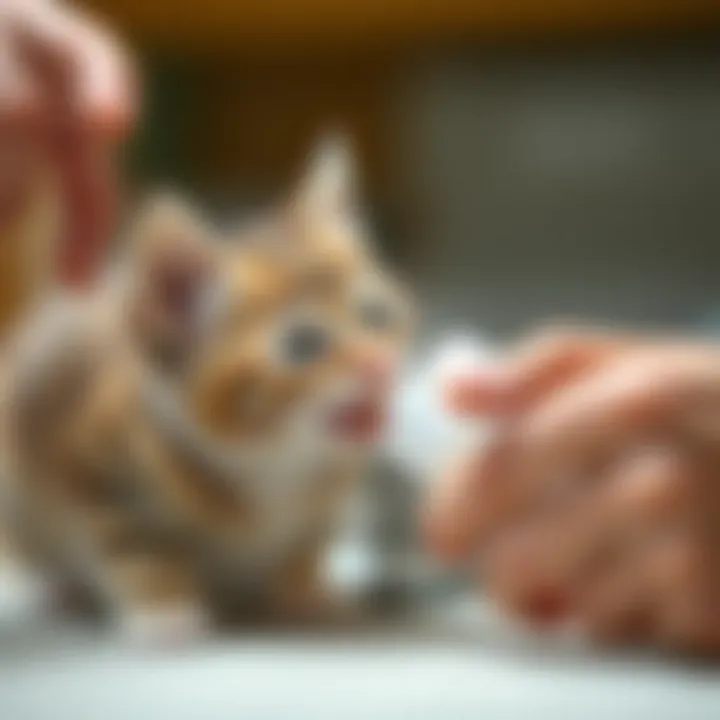
For those who want to dive deeper into kitten care, a plethora of resources exists.
Recommended Books and Websites
- A great starting point for research is The Complete Cat Care Manual.
- Websites like ASPCA provide extensive resources on pet care.
Forums and Groups for Pet Owners
- Joining communities on platforms like Reddit can offer support and shared experiences from fellow pet owners.
Finding Local Services and Classes
- Vet clinics often offer classes about caring for young animals, which can expand your knowledge base.
Encouraging Community Sharing and Contributions
- Sharing personal experiences and insights with fellow pet owners can build a sense of community, fostering better care for all pets.
A well-informed caregiver ensures the next generation of cats flourishes. Investing the time and effort into learning about kitten nutrients and care leads to happier and healthier pets.
Prologue to Feeding Bottles for Newborn Kittens
Feeding bottles cater specifically to the diverse needs of newborn kittens, serving as lifelines for those without a mother’s milk. This section will illuminate their significance, focusing on aspects such as health and emotional well-being. Understanding the pivotal role these bottles play not just in nutrition, but in fostering a bond between caretaker and kitten is vital.
Understanding the Necessity
Many may not immediately grasp why a special feeding bottle is necessary for these tiny creatures. Newborn kittens, especially orphans, require specific nutritional support that only specialized feeding apparatus can provide. Just like a well-tuned instrument makes beautiful music, the right feeding setup ensures kittens receive the essential nutrients they need to grow.
- Health First: Kittens are vulnerable in their earliest weeks, needing formula specifically designed for their growth stages. Regular bottles can fail to deliver the right flow or even carry harmful substances.
- Hydration: Proper hydration in kittens is crucial. Feeding bottles are designed to help kittens sip at their own pace, mimicking natural nursing behavior, ensuring they don’t gulp down air, which could lead to digestive issues.
- Bonding: Using a feeding bottle isn’t just about nutrition. It's also a chance to build a relationship. Holding a kitten close while feeding not only comforts it but also lays the groundwork for trust.
When to Use a Feeding Bottle
Knowing when to introduce a feeding bottle is just as important as knowing how to use one. The timing can make all the difference.
- Motherless Kittens: If a kitten is separated from its mother, feeding bottles become essential. The earlier you introduce the bottle, the better the chances for the kitten to thrive.
- Insufficient Milk Production: Some mother cats struggle with milk production. In these cases, supplementary feeding using bottles helps ensure that every kitten gets its fill.
- Post-Surgery or Illness: After certain veterinary procedures, kittens may require extra care and support. A bottle can be a gentle way to reintroduce food and hydration.
In summary, feeding bottles serve as vital tools for nurturing the delicate life of newborn kittens. Understanding their necessity and knowing when to use them can enhance their chances of survival and growth, setting the stage for a bright future.
Types of Feeding Bottles
The realm of feeding bottles for newborn kittens is vast and filled with options that can greatly impact the success of feeding efforts. Selecting the right type of bottle is paramount. Each kind serves a unique purpose, catering to the specific needs of kittens who are either orphaned or require supplementary feeding. Knowing the distinctions among various feeding bottles aids caretakers in addressing their precious furballs' specific requirements, ensuring they not only receive nourishment but also a chance at healthy growth and development.
Standard Feeding Bottles
Standard feeding bottles are perhaps the most recognized option for kitten care. These bottles mimic the shape and feel of a mother cat's nipple, designed to make the feeding experience as comfortable as possible for a newborn. Made commonly from plastic or silicone, they come equipped with a soft nipple that allows kittens to suckle naturally, which is key for their bonding and comfort.
When choosing a standard bottle, consider the following elements:
- Nipple flow: Different nipples offer varied flow rates. It’s essential to choose one that allows milk to drip slowly, as too fast a flow can lead to choking.
- Size: A smaller bottle may be easier for tiny paws to grasp and hold on to.
- Material: Opting for BPA-free plastic safeguards against harmful chemicals.
Overall, standard feeding bottles blend functionality with a design that caters to kittens’ instincts, making them a crowd favorite among pet owners.
Syringe Feeding
Syringe feeding may be a less conventional method, but it has its merits. For kittens that are too weak to suckle or refuse the bottle altogether, a syringe can provide a valuable alternative. This method allows meticulously controlled amounts of milk to be administered directly into the kitten’s mouth, eliminating the risk of choking that may come with some bottle feeding situations.
Some considerations with syringe feeding include:
- Technique: Hold the kitten upright and gently place the syringe into the side of their mouth, allowing them to swallow naturally.
- Milk quantity: Start with small amounts, gradually increasing as the kitten becomes more accustomed to feeding.
- Temperature of the milk: Ensure the milk is at a comfortable warmth, like that of a mama cat.
This approach not only helps in emergency situations when a kitten is struggling but also allows caretakers to monitor exactly how much nutrition is being consumed.
Specialized Kits
For those looking for convenience, specialized feeding kits have emerged as an excellent solution. These kits often come with a variety of tools, including standard bottles, syringes, and even nipple options designed for various stages of development. The included instructional material can be invaluable for those who are new to kitten care.
Benefits of using specialized kits include:
- Variety: Access to different nipple sizes and shapes caters to diverse needs as the kitten grows.
- Ease of use: Everything you need is in one package, reducing the hassle of hunting down individual components.
- Guidance: Many kits include feeding guides that help caretakers understand their kittens’ nutritional needs at different stages.
The convenience factor combined with the specialized components makes these kits a go-to for many kitten caretakers who want to ensure a comprehensive feeding approach without the trial and error.
Ultimately, the method of choice for feeding will depend on the individual kitten’s needs, the availability of resources, and the comfort of the caretaker. A well-informed choice can lay the groundwork for the kitten’s future.
Choosing the Right Bottle
Selecting the appropriate feeding bottle for newborn kittens is a pivotal decision that can significantly influence their development and overall health. Given their vulnerability, especially when separated from their mothers, the right bottle can help mimic the natural nursing experience as closely as possible. Factors such as material, design, and functionality come into play here, impacting not only how kittens feed but also their comfort and ability to thrive.
Material Considerations
When it comes to kitten feeding bottles, the material plays a vital role, as it affects safety, durability, and ease of cleaning. Bottles are commonly made from plastic, silicone, or glass. Each has its pros and cons:
- Plastic: Lightweight and unbreakable, plastic bottles are often the most popular choice. However, it’s crucial to pick BPA-free plastic, as harmful chemicals can seep into the milk, impacting the kitten's health. Always check the product labeling.
- Silicone: Flexible and generally easy to clean, silicone bottles can be gentle on delicate gums. They offer the added benefit of being resistant to cracking and can be a bit pricier than their plastic counterparts.
- Glass: While considered the safest option in terms of chemical leaching, glass bottles can be heavy and pose a risk of breaking, making them less suitable for handling by new pet owners.
When choosing a feeding bottle, it's essential to prioritize those that are free from harmful substances. Always ensure that they are easy to sterilize since cleanliness is key in preventing infections.
Nipple Size and Shape
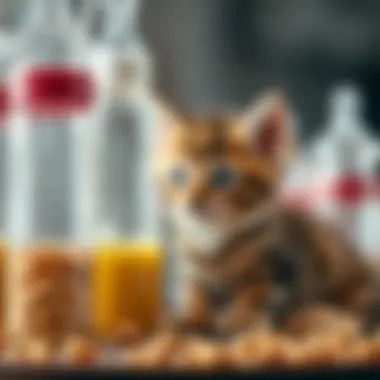
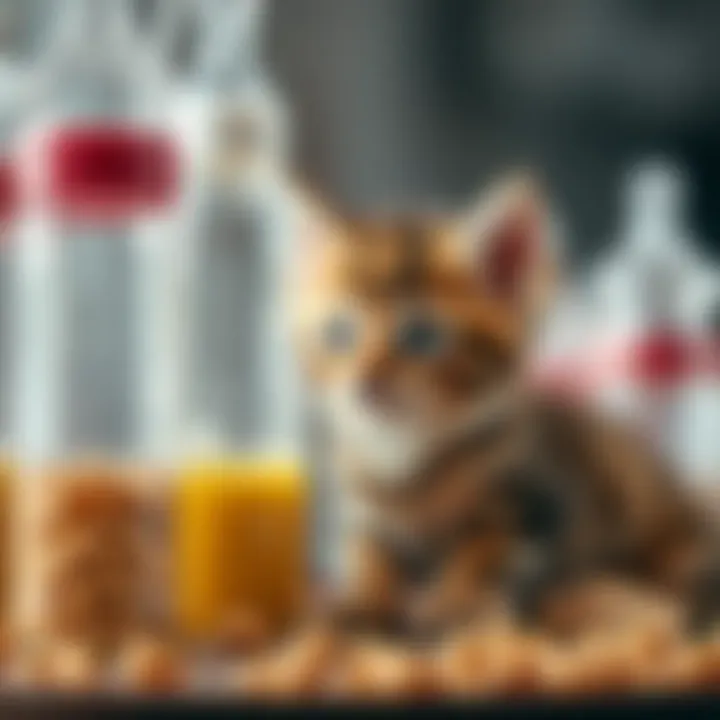
Equally significant is the nipple size and shape of the feeding bottle. These features can make a world of difference in how well a kitten takes to bottle feeding:
- Nipple Size: The size of the nipple's opening should correspond to the age and feeding abilities of the kitten. For neonates, a smaller opening helps control the flow of the milk, while older kittens may benefit from a larger opening. Too large an opening can cause choking, while too small may lead to frustration and refusal to feed.
- Nipple Shape: Some bottles have nipples designed to mimic a mother cat’s teat, allowing for a more instinctual feeding experience. These often feature a wider base and a tapered end, which can promote proper latch and suction.
"A good fit can make all the difference; the right bottle can bridge the gap between instinct and necessity for these fragile creatures."
In addition, consider nipples with various textures as they can provide stimulation similar to what a kitten would experience while nursing. It’s often worthwhile to keep a variety of sizes and shapes on hand, ensuring that any kittens in your care can feed comfortably and effectively.
Preparation for Feeding
Preparing for the feeding of newborn kittens is a pivotal step that shouldn’t be glossed over. It sets the stage for a healthy feeding routine and ensures that the feeding process is smooth and effective. Proper preparation can mean the difference between a content, thriving kitten and one that struggles with nutritional intake, making it essential that caretakers take the time to follow through on this aspect.
Cleaning the Bottle
Before using a feeding bottle, cleanliness is key. Sanitizing the bottle prevents the growth of harmful bacteria that can endanger the kitten’s health. It's vital to wash the feeding bottle thoroughly using hot, soapy water, ensuring that you scrub all parts, especially the nipple, where residue can easily accumulate. Some caretakers might even opt for a steam sterilizer or boiling water for extra assurance.
- Submersion Method: Place the cleaned bottle and nipple in boiling water for several minutes. This will effectively sanitize the items.
- Dishwasher Option: If you're a fan of convenience, placing the bottles in the dishwasher can also do the trick as long as they’re on the top rack to avoid warping.
After cleaning, always allow the pieces to air dry completely. This not only helps to avoid introducing any moisture back into the bottle but also ensures that they are ready for the next feeding with no lingering contaminants.
Preparing the Milk Formula
A proper milk formula is crucial for a newborn kitten’s health, and caregivers have two main avenues to explore when it comes to fulfilling this need.
Commercial Formula Options
Commercial milk formulas are a common choice among caretakers due to their convenience and nutritional balance. These formulas are often specifically designed to mimic a mother's milk, providing kittens with essential nutrients they need during their formative weeks. One of the standout characteristics of commercial formulas is their stability; they are designed to be easy to digest, minimizing potential gastrointestinal issues.
Some popular options include the KMR Liquid Formula and PetAg KMR Powder, which are well-regarded in the pet community. Their popularity boils down to their well-researched composition, which meets the dietary needs of kittens.
However, it's not all sunshine and rainbows. The downsides can be the price tag; these can be more costly than homemade alternatives, particularly for those caring for multiple kittens. That being said, for many, the balance of convenience and nutrition makes these products invaluable in their nurturing arsenal.
Homemade Milk Substitute Recipes
For those who prefer a DIY approach, homemade milk substitute recipes can serve as a suitable alternative; they are generally more cost-effective. A basic recipe might involve mixing goat's milk with a bit of yogurt and raw egg yolk, all blended into a smooth consistency. What makes these substitutes appealing is the control they offer over ingredients, allowing caretakers to avoid preservatives and chemicals found in some commercial options.
Nonetheless, it’s essential to note that homemade mixtures must be used cautiously. Unlike commercial formulas, they might lack certain nutrients vital for a kitten's development, meaning it’s crucial that those choosing this route pay attention to the balance of nutrients. Additionally, these formulas do not have a long shelf life, requiring batch preparation for immediate use.
In summary, both commercial formulas and homemade recipes hold value in their own rights, and the choice often comes down to the individual's preference and circumstances. Each has its unique features, whether it be convenience or nutritional control, but ultimately aim to support the same goal: a healthy, thriving kitten.
For reference, visit these resources on Wikipedia or PetMD for more details on options for kitten milk formulations.
Feeding Techniques
Feeding techniques are crucial to the successful nurturing of newborn kittens. The right approach can significantly affect their growth and overall well-being. Understanding these methods helps caretakers provide optimal care, ensuring that the kittens receive the nutrition they need while also developing bonding and trust with their human caregivers.
Proper Positioning
The way a kitten is held during feeding can influence not just their comfort but also their ability to drink successfully. Positioning is essential. A common practice is to hold the kitten in a slightly elevated position, similar to how they would nurse from their mother. This posture mimics the natural feeding experience and encourages a more effective suckling reflex.
To position a kitten correctly:
- Cradle the kitten in your palm, supporting its body with your fingers.
- Ensure the head is slightly elevated, allowing gravity to assist with the feeding process.
- Use a clean towel or soft blanket to wrap the kitten gently, helping it feel secure and safe.
A well-positioned kitten will often latch onto the nipple more easily, reducing frustration for both the animal and the caregiver. If a kitten resists feeding by squirming or making noises, it might indicate an uncomfortable or unnatural position.
Establishing a Feeding Schedule
Routine is not just for us humans; kittens thrive on it, too. Establishing a consistent feeding schedule is key in ensuring they receive adequate nutrition throughout their early development stages. It helps regulate their eating habits and can prevent issues like overfeeding or malnutrition caused by irregular feeds.
Consider the following when establishing a feeding schedule:
- Frequency of Feedings: Newborn kittens typically require feeding every 2-4 hours. As they grow, this can be adjusted based on their appetite and age.
- Adult Supervision: It’s important to monitor their intake, noting changes or patterns in their feeding behaviors. This observation aids in spotting potential issues early on.
- Adjust for Growth: As the kittens begin to eat solid foods, the schedule will naturally adapt. Transitioning them to a combination of bottle feeding and solid foods is common.
"A feeding schedule not only provides better nutrition but also builds routine, which is comforting for the kittens."
By striking a balance between feeding frequency and kitten comfort, caretakers support the littles ones’ nutritional needs while fostering a healthy habit. This careful attention pays off in the long run, leading to healthier, happier feline companions.
Nutrition for Newborn Kittens
Understanding the nutritional requirements of newborn kittens is crucial for their growth and development. Unlike older cats, kittens have distinct dietary needs that must be met during their early months. At this stage of life, they rely heavily on their mother’s milk or a suitable substitute. If they are orphaned or unable to nurse, it's essential to provide an adequate replacement that mimics feline milk's unique composition.
Kittens generally need a diet rich in protein, fat, and vitamins, which are vital for their physical growth and neurological development. A common pitfall for new cat owners is underestimating the specific nutrients necessary for these tiny creatures. Feeding them incorrect ratios or inappropriate formulas can lead to severe health issues. Thus, a detailed look into nutritional needs is crucial, ensuring that we lay the groundwork for a thriving life ahead of these kittens.
Understanding Nutritional Needs
Kittens require a balanced diet consisting of:
- Proteins: These should come from high-quality sources as they contribute to muscle development and energy levels.
- Fats: Essential fatty acids help support healthy development and provide necessary energy.
- Carbohydrates: While cats are obligate carnivores, some carbohydrates can be included in small amounts for energy.
- Vitamins and Minerals: These are essential for overall health and immune system function.
When kittens are fed their mother's milk, they receive all the essential nutrients, including antibodies that boost immunity. However, when that option isn't available, utilizing specialized commercial formulas is imperative. Brands like KMR or Esbilac can provide the right balance. Moreover, it's advised not to give regular cow's milk, as it can lead to digestive issues due to lactose intolerance in many cats.
Kittens between 0-4 weeks old need frequent feedings, typically every 2-3 hours. This frequency is necessary as their tiny stomachs can only handle small amounts at once. Encouraging good feeding habits from the start sets the tone for their future eating behaviors.
Signs of Malnutrition
Recognizing malnutrition in kittens is vital, as prompt intervention can prevent serious consequences. Here are a few signs to look for:
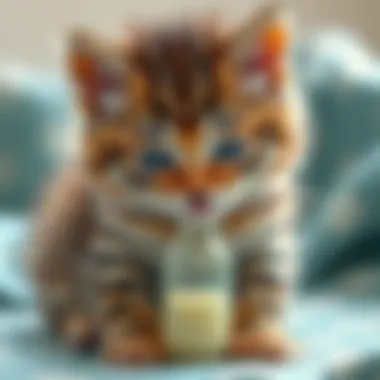
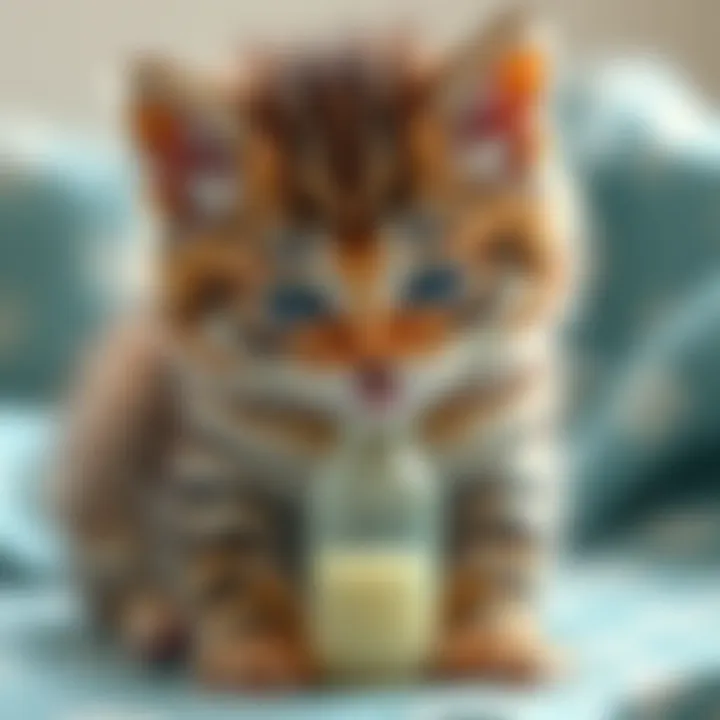
- Weight Loss or Low Weight: If a kitten is not gaining weight appropriately, it can be a red flag of inadequate nutrition.
- Weakness or Lethargy: Kittens should be active and strong. If they seem particularly weak or uninterested in feeding, something might be amiss.
- Poor Coat Condition: A lackluster, dull fur can indicate nutritional deficiency.
- Dehydration: Check for signs of dehydration by gently pinching the skin on the neck; it should return quickly to its original position. If not, this could indicate an issue.
- Abnormal Behavior: Any unusual behavior or reluctance to feed should be addressed. A kitten should show a natural instinct to suckle and feed.
The consequences of malnutrition can be severe, leading to stunted growth and development delays. If there are concerns about a kitten's nutrition, it’s always best to consult a veterinarian to tailor a suitable approach.
Feeding newborn kittens correctly is not merely about filling their bellies. It’s an essential component of raising healthy, vigorous felines that will flourish in their new homes.
Common Challenges in Feeding
Feeding newborn kittens is not always a walk in the park. These tiny creatures are delicate and have specific needs, so it’s crucial to be mindful of the potential hurdles that can arise during feeding sessions. Understanding these challenges allows caretakers to provide better care and ensure that these kittens thrive in their new environment.
For many, feeding is merely a practical task, but when it comes to kittens, it requires a little more finesse and consideration. Each kitten can have its own personality and preferences, creating unique challenges for those who care for them. Addressing issues that arise during feeding can mean the difference between a thriving kitten and one that struggles to grow.
Refusal to Feed
Kittens can be quite fussy when it comes to feeding. If a kitten refuses the bottle, it can be a source of significant worry for caretakers. There are several reasons why a kitten might turn its nose up at the feeding bottle.
- Scent and Temperature: Kittens are sensitive to smells, and if the milk doesn't smell right or is at the wrong temperature, they may refuse it.
- Nipple Design: Some nipples may not feel comfortable to them, making it hard to suckle properly. A good fit is essential here.
- Health Factors: A kitten suffering from an underlying health problem may lack the desire to feed.
It's crucial to observe the kitten's behavior and see if it shows any signs of distress or discomfort. Providing a calm environment and choosing the right milk replacer can greatly influence a kitten's willingness to eat. If a kitten is reluctant to eat, try warming the milk slightly and using different nipple shapes to see if that makes a difference.
Overfeeding Risks
On the flip side, the eagerness to ensure a kitten is well-fed can lead caregivers to the mistake of overfeeding. This can pose serious risks to their health. It’s vital to be aware of the typical serving sizes and to watch for signs of overfeeding.
- Stomach Distention: If a kitten’s belly is swollen or firm post-feeding, it could indicate overfeeding.
- Vomiting: Kittens might vomit if they consume too much at once, which can, in turn, create a risk of aspiration.
- Diarrhea: An overload of milk can upset their digestive systems, leading to loose stools, which can cause dehydration.
Monitoring a kitten's intake and adjusting feeding guidelines based on its age and size can prevent these pitfalls. It's advisable to keep track of how much each kitten is consuming and create a gradual feeding plan. Always observe the kitten following a feeding session to ensure it's not experiencing issues.
Remember: Consistency and attentiveness during feeding are key factors to ensuring the well-being of your newborn kittens. Every kitten is unique, and adapting to their individual needs is part of the nurturing experience.
Post-Feeding Care
When it comes to feeding newborn kittens, the work doesn’t stop once the bottle is empty. Post-feeding care plays a crucial role in ensuring the health and well-being of these delicate creatures. This stage is more than just a routine; it can significantly affect a kitten's growth and overall development. Hence, pet owners must pay close attention to what happens after feeding, as it involves practices that not only promote comfort but also prevent complications that could arise.
Burping Techniques
Just like human infants, kittens may swallow air while feeding, which can lead to discomfort and excessive gas. As such, burping them is an essential part of post-feeding care. There are simple techniques to achieve this:
- Hold the Kitten Upright: Cradle the kitten in a vertical position against your shoulder.
- Pat Gently: Use your palm to gently pat their back; don’t thump, as that could be too jarring. Aim to be gentle yet firm.
- Consider Your Hand Placement: Some caretakers find that stroking down the spine while gently squeezing their tummy can also help.
- Timing is Important: Wait a few minutes after each feed to try and elicit a burp. If nothing comes up, it’s not the end of the world, but try again if you notice any signs of discomfort.
Burping helps in relieving tension in the kitten’s belly and can prevent fussy behavior later on. While some kittens may not need it as much as others, establishing this practice early can prevent future discomfort.
Monitoring Health and Behavior
After feeding, it’s crucial to observe the kittens for any signs of health issues. Monitoring their health and behavior will help ensure they are thriving. Here are some things to keep an eye on:
- Eating Habits: Changes in appetite can indicate ongoing health issues.
- Stool Consistency: Monitor the kitten’s stools. Diarrhea or constipation can suggest digestive problems or dietary intolerance.
- Activity Level: Besides their physical health, their energy levels can indicate overall well-being; a lethargic kitten may need immediate evaluation.
- Weight Gain: Regularly weigh the kittens to ensure they are gaining weight consistently. Ideally, they should be gaining about 10-15 grams per day during their first few weeks.
- Signs of Illness: Watch for symptoms of potential illness, like sneezing, coughing, or unusual behavior towards food or other kittens.
"Daily observation is not just a precaution; it’s a lifeline for neonatal kittens. Every small detail contributes to making the best decisions for their care."
Establishing a routine for monitoring behaviors can be beneficial in catching early signs of distress. It’s about developing a keen eye and realizing what is normal for each kitten, so that any deviations can be addressed quickly.
By paying attention to these post-feeding practices, caretakers can significantly improve the odds of fostering healthy and happy kittens. Every little action contributes to their journey into adulthood.
Transitioning to Solid Food
As newborn kittens begin to grow, the time eventually comes for them to make a significant shift in their dietary habits. Transitioning from a bottle to solid food is not just a matter of introducing new textures and tastes; it's a pivotal stage in their development. This process helps establish a healthy palate and contributes to their overall nutrition and well-being. Understanding the right timing and types of solid food is essential for pet owners, who want to ensure their furry friends flourish during this formative phase.
Timing for Transition
Generally, the optimal age to start weaning kittens is around four weeks. At this point, they should have already been introduced to liquids and might be able to lap up milk from a dish. This is a gradual transition; each kitten is unique, and their readiness will vary. Watch for signs that indicate they are ready for solid food:
- Curious Behavior: If your kitten shows interest in what others are eating or tries to nibble on any solid food you might have out, it’s a good indicator.
- Teeth Development: The emerging baby teeth can suggest that they’re ready to tackle something a bit more substantial.
- Healthy Growth: Ensure the little ones are gaining weight and exhibiting normal activity levels.
Monitor them closely during this time. Gradually phasing in solid food will help prevent potential digestive upsets, and it’s wise to pair the introduction to solid food with their regular feedings, using smaller amounts to start. The rule of thumb is to take it slow but steady.
Types of Solid Food Appropriate for Kittens
When it comes to solid food for kittens, the choices can feel overwhelming. Yet, some options are particularly well-suited for their developing bodies. Here’s a quick rundown:
- Wet Kittens Food: This can be very enticing for young ones; its moisture content is helpful as they adjust. Choose brands with high protein content and without fillers.
- Dry Kibble Formulas: Meanwhile, kibble can also be introduced gradually. Opt for high-quality kitten formulations that support growth and have a balance of essential vitamins.
- Home-Cooked Options: If you prefer preparing meals at home, ground meats like chicken or turkey, mixed with some vegetables (without seasoning) can be appealing.
- Commercial Pâté: A very palatable option! This is usually soft and may be easier for them to eat when they are just starting out.
It’s important to choose foods specifically designed for kittens due to their unique nutritional needs. Avoid feeding them dairy or human food as these can lead to digestive issues. As the kittens continue to adapt to eating solid food, it's wise to encourage variety in their diet to ensure they get a well-rounded intake.
"A diverse diet in young kittens not only keeps them nutritionally balanced but also plays a critical role in shaping their tastes for the future."
As the kittens progress in their eating habits, you’ll find that encouraging them to taste different foods can be a rewarding experience for both of you. Stay observant during this phase, and keep in mind that fostering a healthy eating pattern early on will set a foundation for their lifelong well-being.
The End
Understanding the nuances of feeding newborn kittens, particularly through the use of specialized feeding bottles, is paramount for their survival and health. Newborns, especially those orphaned or without a mother’s milk, rely heavily on proper feeding techniques to develop. The right feeding bottle equipped with an appropriate nipple can make all the difference, offering them not only nourishment but also the behavior patterns associated with natural nursing, which contributes to their emotional well-being.
Feeding isn’t merely about filling a bottle with milk; it’s a holistic approach to fostering a healthy development in these fragile creatures. Caretakers must be astute in their observation—recognizing signs of hunger, ensuring the formula is suitable, and being vigilant about overfeeding or refusal. These aspects contribute significantly to the kitten’s growth trajectory.
Moreover, transitioning kittens to solid food must be approached with care and timing in mind. This phase can be tricky and stresses the importance of a solid foundation laid during the bottle-feeding stage. Maintaining an attentive eye on their health, behaviors, and interactions helps mitigate potential health issues, setting the stage for a strong, vibrant future.
In sum, the act of feeding newborn kittens transcends the physical act; it embodies a commitment to providing them a fighting chance at life. As one becomes attuned to their needs, the experience can transform from a mere responsibility to a rewarding connection, showcasing the remarkable resilience found in these little beings.
"A mother's love is not limited to birth, but includes the nurture and bond formed through care and attention."
Final Thoughts
It’s important to remember that feeding newborn kittens is not just a routine. It is a vital aspect of caring for vulnerable animals that rely on us. By being educated about the various types of feeding bottles, understanding nutritional needs, and recognizing challenges, we equip ourselves with the knowledge needed to care deeply for these little lives. This guide serves as a compass to navigate the sometimes turbulent waters of kitten care, ensuring that every step taken fosters a healthy, thriving future for each kitten.















